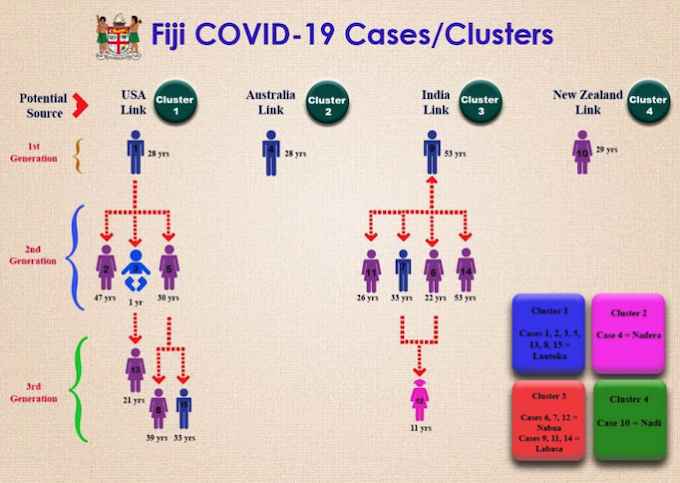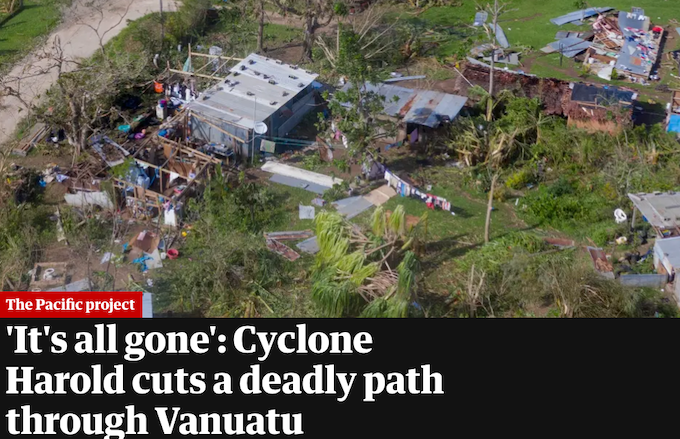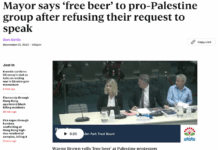DISPATCH FROM THE PACIFIC: By Professor Elisabeth Holland. She writes from a remote island in Fiji’s Koro Sea where she went to stay out of the way of Covid-19, as named by the World Health Organisation (WHO), or SARS-CoV-2, as named by the International Committee on Taxonomy of Viruses. The island is in the Lomaviti archipelago. It is a short boat trip from Makogai, a leper colony tended by the Catholic sisters until the 1960s, a promising place to avoid Covid.
On Easter Sunday, Fiji had 16 cases of Covid-19 (see Fiji clusters image). Prime Minister Voreqe Bainimarama announced Fiji’s first confirmed case of Covid on 19 March, 2020 – a flight attendant on a Fiji Airways flight from San Francisco to Nadi who roamed around Lautoka and attending Zumba class before feeling ill.
The Fiji announcement was made within a week of the arrival of the WHO test kits. An isolation unit, just outside of the capital city Suva had been staffed since January, along with a test facility set up in February.
Coincident with the announcement of the first Covid case, Prime Minister Bainimarama announced the suspension of all Fiji Airways flights through May 29, a 14-day lockdown of the port city of Lautoka, isolation of the ill patient. his family and close contacts with thorough contact tracing, a 10pm to 5am curfew, a ban on gatherings of more than 20 people, and a call for social distancing.
READ MORE: Al Jazeera coronavirus live updates – Conformed cases top 2.5 million worldwide
With case number 5, inter-island transport of people was suspended to prevent the spread of Covid-19 among the islands.
On Thursday, April 2, with the announcement of cases 6 and 7 – haircutters in two separate popular local hair salons – Suva was locked down, and contact sports, including touch rugby, a national pastime, and social gatherings, including customary kava gatherings, were forbidden.
The curfew was extended from 8pm to 5am. The contact tracing for case #9, father of case #7 identified 830 contacts.
A woman and her son, with a history of possible Covid exposure, arrived on our remote island at 10pm on April 2, potentially compromising the health of 139 people on the island who had just completed a 14-day island quarantine.
The violation of the ban on interisland transport plus subsequent quarantine violations made the national news. Hundreds of people have been charged for quarantine and curfew violations.
Two rugby players were arrested and placed in isolation after violating quarantine restrictions.
On April 16, Fiji extended the quarantine period from 14 to 28 days for returning citizens and 28 days of isolation for positive Covid-19 cases.

According to the WHO situation report #83 released on April 12, Easter Sunday, 16 Pacific countries and territories remained free of confirmed Covid-19 cases: American Samoa, Cook Islands 🇨🇰, Federated States of Micronesia 🇫🇲 , Kiribati 🇰🇮, Nauru 🇳🇷, Niue 🇳🇺, Palau 🇵🇼, Pitcairn, Republic of the Marshall Islands 🇲🇭, Samoa 🇼🇸, Solomon Islands 🇸🇧, Tokelau 🇹🇰, Tonga 🇹🇴, Tuvalu 🇹🇻, Vanuatu 🇻🇺, and Wallis and Futuna.
By April 22, independent Pacific island countries of Papua New Guinea and Timor-Leste have seven and 23 confirmed cases of Covid-19 respectively.
By comparison, the French associated territories of French Polynesia have 56 cases, and New Caledonia has 18 cases. The US territories of the Northern Mariana Islands has 14 Covid-19 cases (two deaths), and Guam, home to a US military base, reported 136 Covid-19 cases (5 deaths). However, the April 12 issue of The New York Times reports 585 cases on the USS Theodore Roosevelt docked in Guam, including the now famous Captain Crozier, fired for speaking up on behalf of his men.
Covid-19 and Tropical Cyclone Harold
With Fiji, the Pacific and the world anxious about Covid, Tropical Cyclone Harold spun into existence and began its devastating Easter path across the Pacific. Imagine trying to practise shelter at home and social distancing while simultaneously preparing for a tropical cyclone that was gaining ferocity.
Windows were boarded, evacuation centers were prepared and adequate food and clean water were secured where possible. Generators were serviced and tested.
In early April, while awaiting confirmation of the first case of Covid-19, the Solomon Islands government ordered city dwellers to return to their home villages to reduce the density of people in the capital of Honiara in Guadalcanal and to provide security of place.
On April 4, some 600 Are Are residents of Honiara and Malaita boarded the MV Taemarehu ferry to make their way home.
MV Taemarehu ran into the rough seas generated by Tropical Cyclone Harold, then rated as category one. Twenty-seven people were washed overboard and reported missing.
Solomon Islands has no confirmed cases of Covid, partly due the difficulty of transporting tests to Australia when all aircraft into and out of the Solomon Islands are grounded. The situation is beautifully described in an article by the ever insightful Transform Aqorau, the Solomon Islands permanent representative to the UN, now stranded in New York City.
By Monday, April 6, Tropical Cyclone Harold had intensified to category 5 (Australian scale) with wind speeds in excess of 198 km/h. Four northern islands of the independent nation of Vanuatu: Santo, Pentecost, Ambrym, and Malo were directly hit by the TC Harold.

Luckily, TC Harold arrived on Santo with the low tide. Luganville, on the island of Santo, the second most populous city of Vanuatu, suffered tremendous damage and is struggling to provide food, power and water.
The Vanuatu Daily Post reported the following from Luganville:
“For Lord Mayor Patty Peter, the experience was overwhelming. In an emotional phone call to media in Port Vila Tuesday. he said, ‘We urgently need water, food and shelter at the moment. Many have lost their homes. Schools are destroyed. Electricity is down. I’m urgently calling for help. This is one of the worst experiences of my life.'”
Lord Mayor Peter later confirmed that food and water were being distributed, but “just for today and tomorrow. That’s all that we can do”.
The town has shrugged off smaller cyclones countless times in the past. “But this one, like, it’s a nightmare. It’s a nightmare for all the people in the northern islands,” said Peter.
One of my PhD students has launched a social media campaign to rebuild his family home, and his neighbor’s homes in Luganville after they more than 50 percent of the buildings were destroyed by TC Harold.
Montin Romone, a ni-Vanuatu master’s student in climate change at the University of the South Pacific in Fiji, says in an e-mail:
“My family on North Malekula are safe despite all the root crops have been totally destroyed. Yesterday, I also was informed by my family on Malakula that my dad’s smaller brother died at Santo hospital when TC Harold blew off the roof of the emergency room he was sleeping in. He was so panic as there were no doctors around as well. No electricity due to power cut by the hurricane. Only my smaller brother was there but could not do anything to protect him so he finally died at 1:00 am on that night. As doctors did not allow him to be put into the cold room, so my brother with the help of 4 other boys had to dig a hole in the municipal cemetery and bury him that evening.
“Otherwise, family on Malekula are safe. Unfortunately, I lost two of my cattle but its better than losing another family member.”
With no confirmed cases of Covid, Vanuatu, has forbidden any relief workers from entering the country. Vanuatu will manage the TC Harold relief themselves, and permit delivery of specifically requested supplies.
All incoming supplies are subject to a three day quarantine in the capital before being shipped to the Northern Islands.
Since Vanuatu was hit by record-setting TC Pam in March 2015, the government has committed to building internal capacity for disaster relief. During TC Pam, managing the relief workers and their individual agendas proved to be more difficult than the relief work itself. Recognising the challenge of managing Covid in a small country with limited resources, and only two ventilators, Vanuatu declared a state of emergency and closed its borders in February.
In Covid-19 efforts to repatriate non-citizens, Fiji Airways airlifted at least two flights of expatriates out of the Pacific Islands just hours before Tropical Cyclone Harold arrived.
By 2am on Thursday, April 8, TC Harold’s winds arrived on the main island of Fiji’s Viti Levu on a more northerly, and more populated, track than originally forecast. The incoherent eyewall spun off two tornadoes one in Nausori and another in Tailevu.
TC Harold generated substantial damages through many of Fiji’s more than 300 islands. TC Harold arrived in Kadavu at midday with the king tide and impacted the small island communities of Buliya, Dravuni, and Narikoso in Astrolabe Reef in the Ono district.
A state of disaster for the next 30 days has been declared for the Viti Levu’s Central and Western divisions including Tailevu North, Korovou, Nausori, Nakasi, Beqa and Yanuca and in the district of Nadarivatu, Vatulele, Mamanuca Group, the Yasawa Group, coastal communities in the Coral Coast and along the Sigatoka River in the Nadroga/Navosa province, and the Southern Lau Island group on Fiji’s southeastern perimeter.

During the night of April 8, TC Harold left Fiji to continue onto Tonga passing south of the capital island of Tongatapu. The capital of Nuku’alofa experienced the worst storm surge ever seen when TC Harold arrived in the early morning hours of April 9 accompanying the king tide of the full moon.
The swathe of destruction focused on E’ua Island and several resorts on the north side of Tongatapu. The Tonga “no plastics” campaign has organised clean up campaigns on the seawall in Nuku’alofa.
Tonga has no confirmed cases of Covid-19. Tonga declared a state of emergency on 19 March 2020, closing its borders completely when Fiji announced its first Covid-19 case.
Climate change, disaster risk management and Covid-19
Fiji and the Pacific leaders work to lead with the concept of stewardship motivating their action. The 2016 anniversary of record setting Tropical Cyclone Winston was in February, just days after Fiji had been the first country in the world to ratify the 2015 Paris Agreement.
With a population of less than a million people, Fiji went on to be both the President of the UN to host the UN Oceans Conference and serve as President of the UNFCCC COP23 in 2017.
Similarly, the 2015 record setting Tropical Cyclone Pam crashed into Port Vila, Efate, Vanuatu during the negotiation of the Sendai Framework for Disaster Risk Reduction. Development donor investments in the region are guided by the Framework for Resilient Development which recognised the need to simultaneously address disaster preparedness, climate change and development of low carbon economies.
Symbolic of the collective nature of Pacific culture, Prime Minister Bainimarama calls upon Fiji to honour the power of the spirit of “vei lomani” – that profound sense of love and devotion to the protection of our people.
The Pacific leaders are determined to lead by example to prevent the devastation of Covid in their countries. With the fresh memory of late 2019 measles epidemic in Fiji, Samoa, Tonga and American Samoa resulting in 83 deaths in Samoa, Samoan borders were closed in February.
None of the independent Pacific countries have robust medical or epidemiological research programmes, yet these leaders acted on the basis of science while leaders of other countries were still debating whether stay at home measures were required.
Pacific Islands countries suffered tremendously from the diseases brought by early explorers, including smallpox, measles, syphilis and gonorrhea. In recognition of their limited resources and the advantages of their remote location, Pacific countries have acted early to protect themselves and close their borders, with considerable success to date.
The alarm and fear accompanying Covid is a galvanising action. Papua New Guinea with an abundance of natural resources and people, but plagued by a lack of adequate medical facilities and decades of struggles will likely face the greatest challenges in dealing with Covid-19.
In recognition of the importance of UN support agencies, like the UN’s World Health Organisation, the Pacific leaders welcomed the WHO director Dr Tedras Adhanom Ghehreyesus to the 50th Pacific Islands Forum Leaders meeting last August, establishing an effective network of relations just months before the arrival of Covid-19.
Professor Elisabeth Holland is the director of the Pacific Centre for Environment and Sustainable Development (PaCE-SD) at the University of the South Pacific. In 2007, she was a co-recipient of the 2007 Nobel Peace Prize for her contribution to the Intergovernmental Panel on Climate Change (IPCC).










































This article is such an inspirational one with insights on both collective and individual actions to mitigate COVID-19 as well as the devastation of TC Harold. It gives a glimpse of the Pacific leaders if they are doing the right thing to take action to prevent natural disasters. A lesson that we need to reflect on in order to prepare for an anticipated pandemic and natural disaster in the future.
Comments are closed.